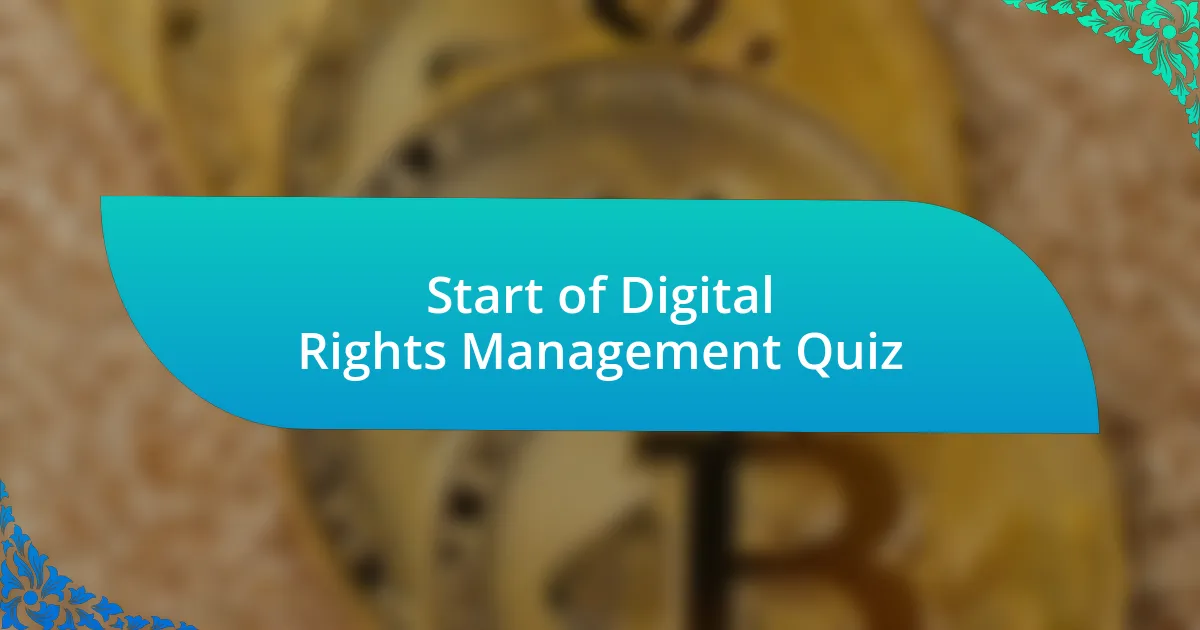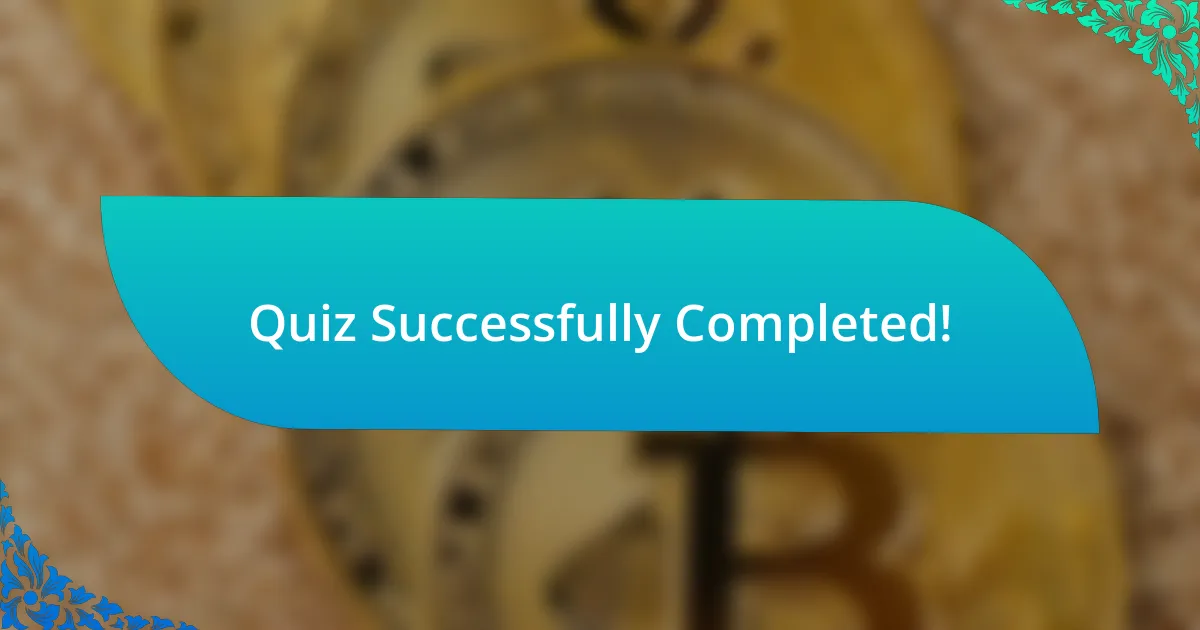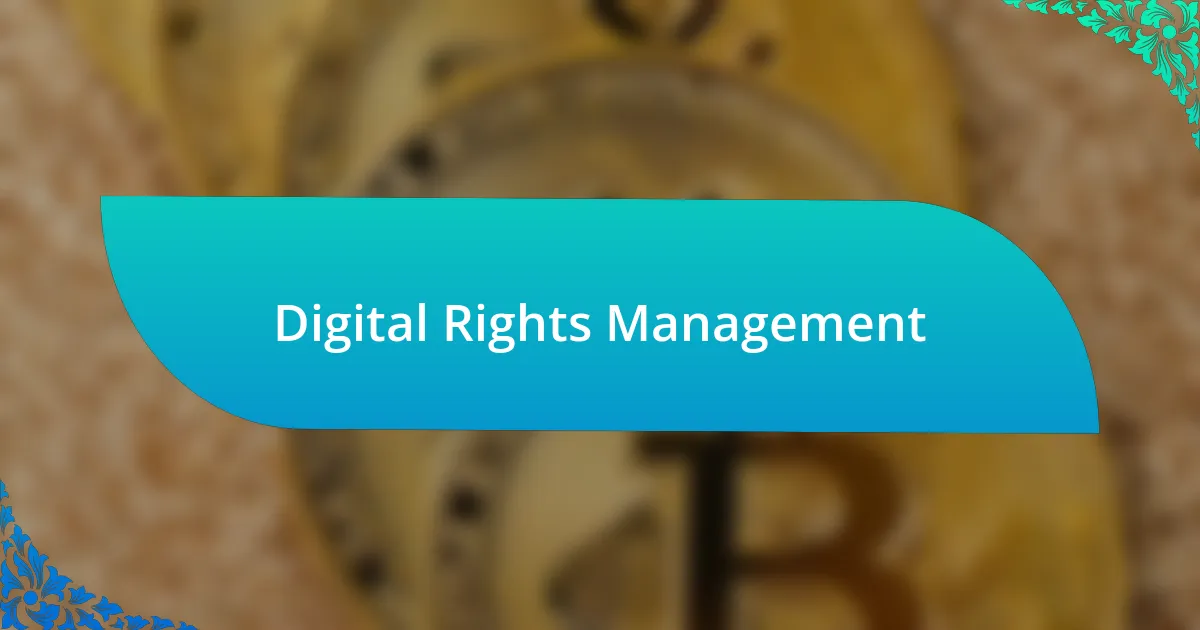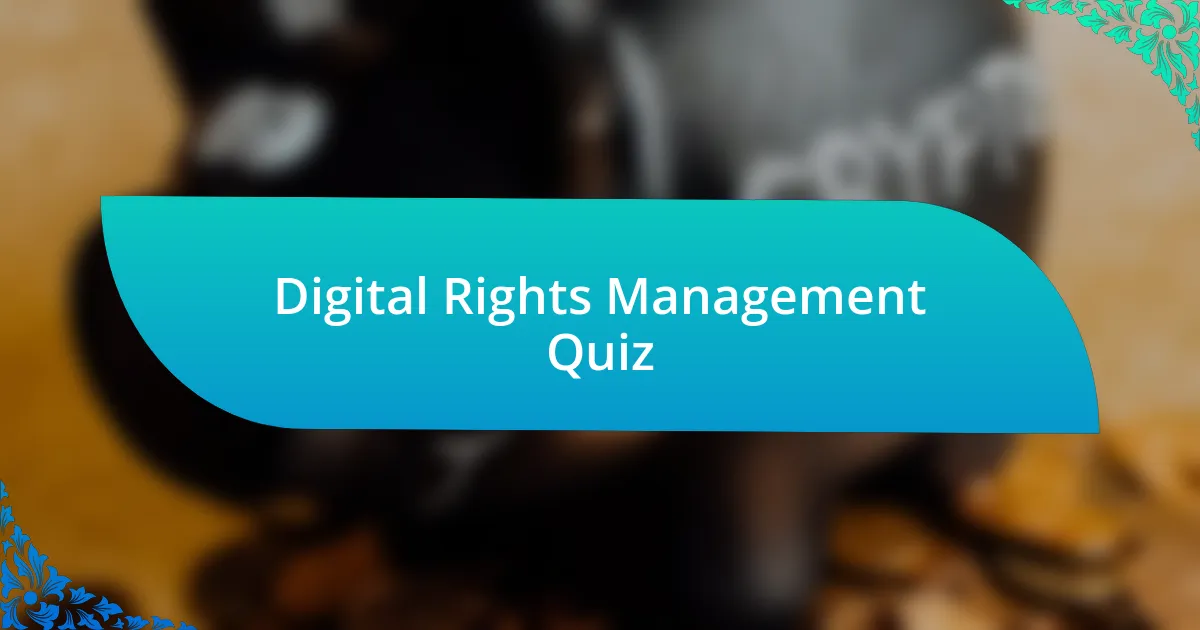
Start of Digital Rights Management Quiz
1. What is the relationship between digital rights management (DRM) and Ethereum?
- Ethereum is primarily used for banking and interest calculations.
- Ethereum primarily focuses on social media and content creation.
- Ethereum can help manage digital rights through smart contracts and decentralized applications.
- Ethereum is a digital storage technology for multimedia files.
2. How can Ethereum smart contracts enhance DRM functionalities?
- Ethereum smart contracts increase DRM content size and quality.
- Ethereum smart contracts automate DRM rights management and enforcement.
- Ethereum smart contracts allow free access to all digital content without restrictions.
- Ethereum smart contracts eliminate the need for any digital rights policies.
3. In what way can Ethereum be used to prove ownership of digital assets protected by DRM?
- Ethereum manages the encryption of all digital rights automatically without user involvement.
- Ethereum can be used to issue unique tokens that represent ownership of digital assets.
- Ethereum enables unlimited free access to all digital content without restrictions.
- Ethereum can be used to create copies of digital assets without any legal limitations.
4. What role do NFTs play in the context of DRM on the Ethereum blockchain?
- NFTs are primarily used to store traditional documents securely on the blockchain.
- NFTs serve as proof of ownership and authenticity for digital assets in DRM on Ethereum.
- NFTs act as a substitute for physical currencies in online transactions.
- NFTs function as a method to permanently delete digital content from the blockchain.
5. How does decentralization in Ethereum impact traditional DRM models?
- Decentralization increases the cost associated with license management processes.
- Decentralization allows for more user control and reduces reliance on centralized entities for asset verification.
- Decentralization guarantees that all digital content remains free to access and modify.
- Decentralization eliminates the need for digital rights enforcement entirely.
6. What are the benefits of combining DRM with Ethereum for content creators?
- Reduced legal obligations for content creators.
- Increased exposure through free content distribution.
- Enhanced revenue through direct sales and royalties for creators.
- Unlimited access to all forms of digital content.
7. How can Ethereum enable automatic license management for digital content?
- Smart contracts can automate license terms.
- Ethereum prevents data overload on servers.
- Ethereum gives users access to physical libraries.
- Ethereum enhances graphics in video games.
8. What challenges does Ethereum face regarding DRM enforcement?
- Complete anonymity in transactions
- Unlimited data storage capability
- Difficulty in ensuring compliance with licenses
- Instant access to all content without restrictions
9. How does Ethereum ensure the security of digital rights management data?
- It ignores user authentication processes.
- It uses encryption to secure digital content.
- It openly shares all digital assets online.
- It eliminates copyright law relevance.
10. In what way does Ethereum enhance transparency in digital rights management transactions?
- Smart contract execution
- Manual audits of transactions
- Centralized database management
- Traditional licensing agreements
11. How can smart contracts on Ethereum simplify the process of DRM compliance?
- Smart contracts create physical copies of digital assets for distribution.
- Smart contracts automate licensing verification for digital content.
- Smart contracts eliminate the need for copyright laws altogether.
- Smart contracts prohibit all forms of digital content usage.
12. What is the impact of Ethereum-based DRM on piracy in the digital content industry?
- It leads to more copyright infringement by enabling sharing.
- It increases piracy by making content more available.
- It has no effect on piracy in the digital content industry.
- It significantly reduces piracy by providing secure access to digital content.
13. How do gas fees affect the implementation of DRM solutions on Ethereum?
- Gas fees have no impact on the efficiency of DRM solutions on Ethereum.
- Gas fees reduce the security of DRM solutions on Ethereum.
- Gas fees can affect transaction costs and limit access to DRM solutions on Ethereum.
- Gas fees increase the visibility of DRM solutions on Ethereum networks.
14. Can Ethereum be used to create a more equitable distribution of royalties through DRM?
- Yes, Ethereum can help create fair royalty distribution through DRM.
- No, Ethereum cannot be used for royalty payments.
- No, Ethereum only supports physical asset management.
- Yes, Ethereum limits royalty distribution effectiveness.
15. What potential future developments in Ethereum could improve DRM practices?
- Development of offline storage options
- Implementation of smart contracts for licensing
- Integration of traditional banking systems
- Creation of a new cryptocurrency
16. How is the concept of digital licenses evolving with Ethereum’s blockchain technology?
- Digital licenses are only used for physical goods transactions.
- Digital licenses are printed on paper for legal verification.
- Digital licenses are managed through smart contracts on Ethereum’s blockchain.
- Digital licenses are issued by government agencies only.
17. What role does Ethereum play in protecting user data within DRM frameworks?
- It serves as a platform for distributing digital art without restriction.
- It provides free access to all digital content.
- It supports secure sharing and access control of digital rights.
- It eliminates the need for copyright protection.
18. How can Ethereum create a marketplace for DRM-protected digital assets?
- Ethereum creates a centralized asset control.
- Ethereum uses smart contracts for DRM marketplace.
- Ethereum utilizes traditional licensing methods.
- Ethereum relies on physical storage solutions.
19. How does Ethereum`s immutability benefit DRM analytics and reporting?
- It removes all copyright restrictions on assets.
- It makes digital content easily alterable by users.
- It creates a transparent audit trail for usage data.
- It allows unlimited sharing of digital content.
20. What are the implications of Ethereum-based identity solutions for DRM?
- Ethereum-based identity solutions eliminate the need for copyright laws entirely.
- Ethereum-based identity solutions can enhance user privacy and control over their digital rights for DRM.
- Ethereum-based identity solutions prevent all forms of digital content distribution.
- Ethereum-based identity solutions guarantee unrestricted access to all digital content.
21. How can Ethereum facilitate cross-border digital rights management for content creators?
- Ethereum only tracks cryptocurrencies without content rights.
- Ethereum can only facilitate content creation, not management.
- Ethereum`s blockchain is irrelevant for digital rights management.
- Ethereum`s smart contracts can automate licensing and royalty payments.
22. What role does community governance in Ethereum play in shaping DRM policies?
- Community governance allows stakeholders to collaboratively create DRM policies that reflect collective interests.
- Community governance is mainly about improving the efficiency of cryptocurrency mining processes.
- Community governance solely addresses the allocation of network storage resources.
- Community governance primarily focuses on enhancing user interface design and aesthetics.
23. How might Ethereum`s programmability enhance the functionality of DRM systems?
- Ethereum eliminates the need for encryption methods in DRM systems.
- Ethereum can automate license management and enforce digital rights dynamically.
- Ethereum restricts all digital transactions across networks without exception.
- Ethereum prevents all forms of user access to digital content entirely.
24. What is the significance of tokenization of digital assets in Ethereum for DRM purposes?
- Tokenization removes the need for encryption in DRM processes.
- Tokenization allows for secure, verifiable ownership tracking of digital assets in Ethereum for DRM.
- Tokenization prevents users from accessing digital assets altogether for DRM.
- Tokenization enables easy sharing of files without any restrictions for DRM.
25. How can Ethereum`s decentralized identity solutions help with DRM authenticity verification?
- It focuses primarily on reducing the cost of content distribution.
- It can provide tamper-proof verification through secure access management.
- It eliminates the need for tracking user engagement with the content.
- It increases the number of digital copies made available to everyone.
26. What are the differences between traditional DRM and blockchain-based DRM using Ethereum?
- Traditional DRM is only applicable to music, while blockchain-based DRM covers all types of digital content.
- Traditional DRM is free for all users, but blockchain-based DRM has costs associated with transactions.
- Traditional DRM relies on centralized servers, while blockchain-based DRM uses decentralized ledgers for transparency.
- Traditional DRM does not require any encryption, whereas blockchain-based DRM does.
27. How does Ethereum address the issue of copyright infringement in the digital age?
- Ethereum does not address copyright infringement at all.
- Ethereum utilizes smart contracts to enforce copyright protection.
- Ethereum allows free access to all digital assets without restrictions.
- Ethereum uses a centralized authority to manage copyright issues.
28. Can Ethereum support DRM for physical assets linked to digital contents, like art?
- Yes, Ethereum can support DRM for physical assets linked to digital content.
- No, Ethereum only supports digital assets without DRM.
- Yes, Ethereum cannot be used for DRM with physical assets.
- No, Ethereum cannot support DRM for physical assets linked to digital content.
29. How do Ethereum fees affect the accessibility of DRM technologies for small creators?
- Ethereum fees make DRM technologies more accessible for everyone, including small creators.
- Ethereum fees have no impact on the accessibility of DRM technologies for large corporations.
- Ethereum fees can limit the ability of small creators to use DRM technologies effectively.
- Ethereum fees reduce the overall cost of using DRM technologies for small creators.
30. What is the potential of Ethereum for building a decentralized DRM ecosystem?
- Ethereum restricts all content access and use.
- Ethereum enables decentralized and transparent DRM systems.
- Ethereum eliminates the need for copyright enforcement entirely.
- Ethereum solely manages physical assets in DRM.

Quiz Successfully Completed!
Congratulations on finishing the quiz on Digital Rights Management (DRM)! We hope you found it insightful and enjoyable. This quiz has covered key concepts surrounding DRM, its importance in protecting digital content, and the various technologies that enable it. You might have learned how DRM affects copyright law, the implications for consumers, and the ongoing debates in the digital landscape.
Reflecting on your answers, you likely gained a clearer understanding of both the advantages and limitations of DRM. It is crucial to recognize how DRM affects not only businesses but also creatives and consumers. By grasping these dynamics, you can better appreciate the delicate balance between protecting intellectual property and ensuring user rights.
We invite you to dive deeper into the subject with our next section dedicated to Digital Rights Management. Here, you’ll find comprehensive information that expands on the topics covered in the quiz. It’s a fantastic opportunity to enhance your knowledge and explore case studies that illustrate DRM in action. Happy learning!

Digital Rights Management
Understanding Digital Rights Management (DRM)
Digital Rights Management (DRM) refers to technologies that control the use of digital content and devices after the initial sale. Its primary aim is to protect copyright and intellectual property rights in a digital environment. DRM technologies include encryption, licensing agreements, and user authentication, ensuring only authorized users can access or replicate digital content. This framework helps content creators and distributors maintain control over their products and prevent unauthorized distribution.
The Purpose and Importance of DRM
The main purpose of DRM is to safeguard the rights of creators and companies in the digital marketplace. It helps prevent piracy, unauthorized sharing, and forgery of digital content. By enforcing usage limitations, DRM protects revenue streams for artists, publishers, and software developers. Without DRM, digital media could be easily copied and shared, undermining the value of original works and reducing incentives for creators to produce new content.
Types of Digital Rights Management Technologies
Various types of DRM technologies exist, each serving unique functions. These include encryption methods that encrypt digital files, requiring a decryption key for access. Digital Watermarking embeds information within digital content for identification purposes. Licensing models dictate how content is purchased and used, including subscription services and pay-per-view options. These technologies work together to enforce restrictions on how content can be viewed, copied, or shared.
Challenges and Criticism of DRM
DRM faces significant challenges and criticism, primarily regarding user accessibility and fairness. Some argue that DRM restricts legitimate use, limiting users’ ability to access content they have legally purchased. Critics also claim some DRM systems can lead to a poor user experience, with excessive restrictions that frustrate consumers. Additionally, aggressive DRM measures may encourage illegal circumvention, undermining the overall effectiveness of protection efforts.
The Future of Digital Rights Management
The future of DRM is likely to evolve with advancements in technology and changing consumer expectations. As digital content becomes more prevalent, DRM solutions must adapt to new distribution methods and formats. Innovations such as blockchain technology are being explored for securing digital rights, offering transparent ownership records. The ongoing challenge will be balancing protection for creators while ensuring user accessibility and satisfaction in a rapidly shifting digital landscape.
What is Digital Rights Management?
Digital Rights Management (DRM) refers to technologies that control access to digital content. It aims to protect intellectual property rights by preventing unauthorized use or distribution of digital media. For example, DRM is used in software, ebooks, music, and films to restrict copying and sharing, as seen with services like Spotify and Netflix.
How does Digital Rights Management work?
Digital Rights Management works through encryption and licensing systems. Content is encrypted, and only authorized users can decrypt it, usually after purchasing or subscribing. Licensing agreements dictate how content can be used. For instance, Adobe uses DRM in its PDFs to limit printing and copying based on user permissions.
Where is Digital Rights Management commonly applied?
Digital Rights Management is commonly applied in various digital media formats, including software applications, movies, music, ebooks, and video games. It is particularly prevalent in online streaming platforms like Amazon Prime Video and digital marketplaces like Apple’s iTunes, where it safeguards content from piracy.
When did Digital Rights Management become widely adopted?
Digital Rights Management became widely adopted in the late 1990s and early 2000s with the rise of digital distribution. Notably, in 1999, the Recording Industry Association of America (RIAA) began pushing for DRM in music distribution to combat rampant piracy as music consumption shifted online.
Who are the key players in Digital Rights Management?
Key players in Digital Rights Management include technology companies like Microsoft, Adobe, and Apple, which develop DRM solutions. Additionally, major content providers like Netflix, Amazon, and Spotify implement DRM to protect their products. These entities work together to enforce digital rights across various industries.

